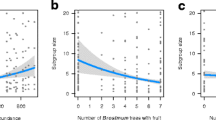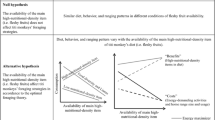Abstract
White-faced capuchins (Cebus capucinus)on Barro Colorado Island, Panama, have a flexible foraging strategy. Typically, foraging party size is small and individuals feed dispersed from one another. When seasonal fruiting of large volume trees occurs, the majority of the group forages simultaneously. As C. capucinusdo not display a rigorous dominance structure and there are few indications that individuals or coalitions monopolize food patches,individuals are expected to display scramble strategies instead of high frequencies of contest competition. I recorded foraging party size (simultaneous foragers), the total number of animals to feed successively, and the diameter at breast height (DBH) of fruit trees used in two habituated troops. Individuals in each group spent a substantial amount of time — 65 and 48% of foraging time for each group — foraging in party sizes of one. Monkeys predominantly foraged alone in small trees (0- to 20- cm DBH), successively in medium trees (21- to 60- cm DBH), and simultaneously in large trees (>61- cm DBH). They used small trees more frequently than all other tree classes. In medium-sized trees, although fruit was plentiful, space was limited. In these trees Cebusforaged successively. In large-volume trees, space and fruit were abundant and several individuals fed together. As the DBH of fruiting trees increased, the average foraging party size increased exponentially. Cebus capucinusat Barro Colorado Island modify their foraging party size to adapt to the seasonal patterns of fruit production.
Similar content being viewed by others
References
Alexander, R. (1974). The evolution of social behavior.Annu. Rev. Ecol. System. 4: 325–383.
Altmann, J. (1974). Observational study of behavior: Sampling methods.Behaviour 49: 227–265.
Altmann, S. (1974). Baboons, space, time and energy.Am. Zool. 14: 221–248.
Bradbury, J., and Vehrencamp, S. (1976). Social organization and foraging in emballonurid bats. II. A model for the determination of group size.Behav. Ecol. Sociobiol. 1: 383–404.
Buckley, J. S. (1983).The Feeding Behavior, Social Behavior, and Ecology of the White-Faced Monkey, Cebus capucinusat Trujillo, Northern Honduras, Central America, Ph.D. thesis, University of Texas at Austin, Austin.
Chapman, C. A. (1990). Ecological constraints on group size in three species of Neotropical primates.Folia Primatol. 55: 1–9.
Fedigan, L. (1993). Sex differences and intersexual relations in adult white-faced capuchins (Cebus capucinus).Int. J. Primatol. 14: 853–877.
Glander, K. E., Fedigan, L. M., Fedigan, L., and Chapman, C. (1991). Field methods for capture and measurement of three monkey species in Costa Rica.Folia Primatol. 57: 70–82.
Hladik, A., and Hladik, C. M. (1969). Rapports trophiques entre vegetation et primates dans la foret de Barro Colorado, Panama.Terre Vie 1: 25–117.
Leighton, M., and Leighton, D. R. (1982). The relationship of size of feeding aggregate to size of food patch: Howler monkeys (Alouatta palliata) feeding inTrichilia cipo fruit trees on Barro Colorado Island.Biotropica 14: 81–90.
Lehner, P. N. (1979).Handbook of Ethological Methods, Garland STPM Press, New York.
Maxwell, S. E., and Delaney, H. D. (1990).Designing Experiments and Analyzing Data, Brooks/Cole, California.
Mitchell, B. J. (1989).Resources, Group Behavior, and Infant Development in White-Faced Capuchin Monkeys, Cebus capucinus, Ph.D. thesis, University of California, Berkeley.
Nicholson, A. J. (1954). An outline of the dynamics of animal populations.Austral J. Zool. 2: 9–65.
O’Brien, T. G. (1991). Female-male social interactions in wedge-capped capuchin monkeys: Benefits and costs of group living.Anim. Behav. 41: 555–567.
O’Brien, T. G., and Robinson, J. G. (1991). Allomaternal care by female wedge-capped capuchin monkeys: Effects of age, rank and relatedness.Behaviour 119: 30–50.
Oppenheimer, J. R. (1968).Behavior and Ecology of the White-Faced Monkey, Cebus capucinuson Borro Colorado Island, Canal Zone, Ph.D. thesis, University of Illinois, Urbana.
Rose, L. M. (1994). Sex differences in diet and foraging behaviour in white-faced capuchins,Cebus capucinus.Int. J. Primatol. 15: 63–82.
Strier, K. B. (1989). Effects of patch size on feeding associations in muriquis (Brachyteles arachnoïdes).Folia Primatol. 52: 70–77.
Symington, M. M. (1990). Fission-fusion social organizationin Ateles andPan.Int. J. Primatol. 11: 47–61.
Terborgh, J. (1983).Five New World Primates, Princeton University Press, Princeton, NJ.
Terborgh, Jr., and Janson, C. H. (1986). The socioecology of primate groups.Annu. Rev. Ecol. System. 17: 111–135.
van Schaik, C. P. (1989). The ecology of social relationships amongst female primates. In Standen, V., and Foley, R. A. (eds.),Comparative Socioecology: The Behavioral Ecology of Humans and Other Mammals, Blackwell Scientific, Oxford, pp. 195–218.
van Schaik, C. P., and van Hooff, J. A. R. A. M. (1983). On the ultimate causes of primate social systems.Behaviour 85: 91–117.
Wrangham, R. W. (1980). An ecological model of female-bonded primate groups.Behaviour 75: 262–299.
Author information
Authors and Affiliations
Rights and permissions
About this article
Cite this article
Phillips, K.A. Resource patch size and flexible foraging in white-faced capuchins (Cebus capucinus). Int J Primatol 16, 509–519 (1995). https://doi.org/10.1007/BF02735800
Received:
Revised:
Accepted:
Published:
Issue Date:
DOI: https://doi.org/10.1007/BF02735800




